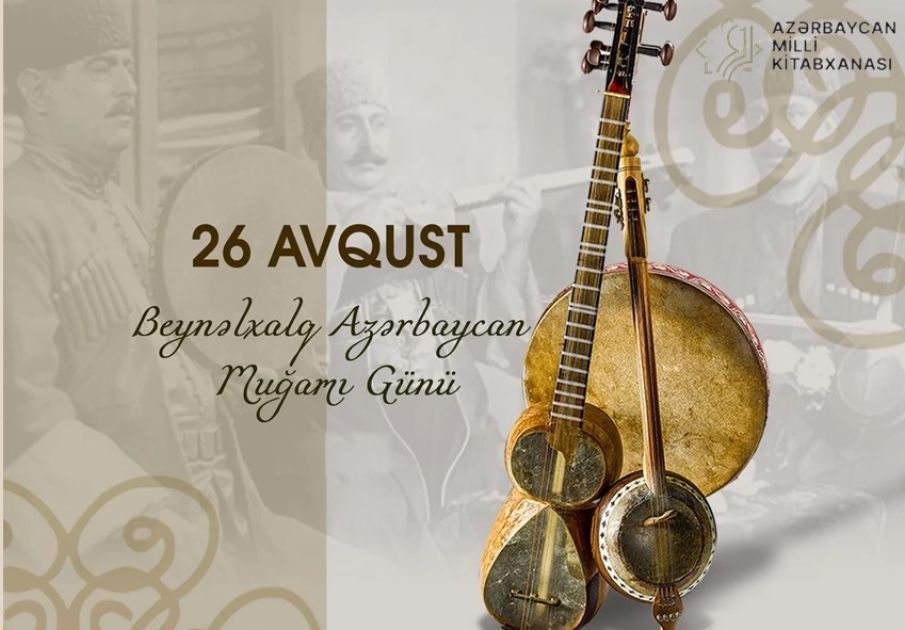The National Library has opened both traditional and virtual exhibitions timed to the International Day of Azerbaijani Mugham, Azernews reports.
The virtual exhibition presents thoughts from prominent Azerbaijani figures about mugham, along with photos, press materials, and books containing full texts.
The main goal of the exhibitions is to promote Azerbaijan's rich mugham heritage, provide opportunities for younger generations to learn more about this ancient art, and contribute to spreading Azerbaijani music worldwide.
The traditional book exhibition showcases literature in Azerbaijani and foreign languages on the historical roots of Azerbaijani mugham, its classification, development stages, instrumental mugham, performance techniques, Azerbaijan's musical heritage, the Garabagh vocal school, famous mugham singers, and their role in the development of Azerbaijani musical culture, among other topics. Those interested in exploring the exhibition can visit the following link.
International Day of Azerbaijani Mugham is celebrated annually on August 26. This day was proclaimed by the Canadian city of Niagara-on-the-Lake and the Niagara International Music Festival in 2010, and it also serves as Music Day for countries along the Great Silk Road.
The adoption of this decision confirms that mugham, a national treasure of the Azerbaijani people, has now become part of global musical heritage. This day holds special significance for mugham enthusiasts, as well as for those who have dedicated their lives to preserving and promoting this ancient art.
Mugham, one of the oldest musical genres in the ancient East, has attracted the attention of researchers for centuries and remains a significant subject in the study of world music culture.
Although mugham has gone through various phases throughout history, it has been preserved and passed down through generations as an ancient heritage of the Azerbaijani people. During Azerbaijan's period of independence, mugham performance entered a new phase of development, playing a crucial role in introducing Azerbaijani culture to the world.
Mugham modes are not only associated with scales but also with an orally transmitted collection of melodies and melodic fragments that performers use during improvisation.
Mugham consists of seven main modes-Rast, Shur, Segah (particularly common), Shushtar, Bayaty-Shiraz, Chahargah, Humayun, and three collateral modes, including Shahnaz, Sarendj, and Chargah in different forms.
A short piece of Azerbaijani mugham performed on the balaban, a national wind instrument, was included on the Voyager Golden Record, attached to the Voyager spacecraft, as a representation of world music among many of humanity's cultural achievements.
The 20th century marked a turning point for mugham, with Uzeyir Hajibayli creating the "Leyli and Majnun" mugham opera, blending mugham and European classical music.
Fikrat Amirov later introduced mugham to symphonic orchestras, based on classical folk pieces, which were performed by renowned symphony orchestras worldwide.
Three major schools of mugham performance developed in the late 19th and early 20th centuries in Garabagh, Shirvan, and Baku.
In the late 1960s and 1970s, a completely new style of mugham emerged in Azerbaijan.
Vagif Mustafazade is regarded as the founder of Azerbaijani jazz-mugham, a genre that blends jazz with traditional mugham.
Azerbaijan's living vocal treasure, Alim Gasimov, has also played a significant role in promoting mugham art. In 1999, he was awarded the International Music Council-UNESCO Music Prize, one of the highest international honors for music.
In 2003, Azerbaijani mugham was proclaimed a Masterpiece of the Oral and Intangible Heritage of Humanity by UNESCO and was inscribed on the Representative List of the Intangible Cultural Heritage of Humanity in 2008.
The International Mugham Center, operating in Baku since 2008, is a marvel of design inspired by elements and shapes of the tar, a national musical instrument used in performing mugham.
Equipment for the building was sourced from Italy, Austria, France, and Turkey, and over 2,000 pieces of glass of various sizes were used in its construction.
Today, the Mugham Center carries out many large-scale projects aimed at promoting Azerbaijani culture, including mugham art. These projects include "Mugham Evenings," "Evenings of Ashug Music," "Pearls of Ethnic Music," "Unforgettable," "Evenings of Dastan," Baku Summer Jazz Days, and others.
The center hosts mugham and jazz festivals, international conferences, and spectacular concerts.

